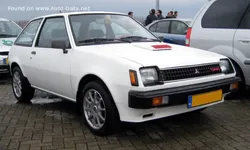

Mitsubishi Colt Generation 1 A150 Overview
Explore the Mitsubishi Colt generation with detailed insights on the Mitsubishi Colt Generation 1 A150. Discover specifications and features of this iconic model in Portugal.
The Mitsubishi Colt Generation 1, also known by its internal code A150, marked a significant milestone in the automotive landscape when it debuted in 1978. This compact car was designed to cater to a growing ...
Technical Specifications
Select Version
Dimensions
Engine
Driving
Others
History and Features
Mycarro AI
Apr 27, 2025
The Mitsubishi Colt Generation 1, also known by its internal code A150, marked a significant milestone in the automotive landscape when it debuted in 1978. This compact car was designed to cater to a growing audience of economical and practical vehicle users. Mitsubishi's vision for the Colt A150 revolved around offering consumers a balance of functionality, affordability, and reliability, facets that were becoming increasingly important during the late 1970s.
Design and Features
The Mitsubishi Colt A150 presented a sleek and modern design for its time, showcasing the typical characteristics of a compact car. With its short overhangs, rounded silhouette, and a minimalist grille, the Colt aimed to resonate with the sensibilities of drivers seeking practicality in a small package. The car was available in various body styles, including a two-door coupe, a four-door sedan, and a five-door hatchback, allowing customers to choose a model that best suited their lifestyles. The versatility in design contributed to the Colt's appeal, making it a popular choice among young professionals and small families.
Engine Options and Performance
Under the hood, the Mitsubishi Colt A150 was equipped with various engine options, catering to different performance needs and preferences. The base model featured a modest 1.2-liter inline-four engine, producing around 65 horsepower. This engine provided adequate performance for urban driving while maintaining impressive fuel efficiency, a critical factor for consumers during the oil crisis of the late 1970s. For enthusiasts seeking more power, Mitsubishi offered higher-spec models with upgraded engines, including a 1.4-liter variant that delivered a sportier driving experience without sacrificing reliability.
Interior Comfort and Technology
Inside the Mitsubishi Colt A150, the focus on practicality continued. The cabin was designed to maximize space, giving both driver and passengers a comfortable experience. Although not luxuriously appointed, the interiors were functional, with supportive seating and straightforward controls that emphasized ease of use. The dashboard housed essential instruments, such as speedometer, fuel gauge, and warning lights, ensuring drivers had a clear understanding of their vehicle's performance.
In terms of technology, the A150 provided basic features typical of the era, including a radio and optional air conditioning. While it did not include modern luxuries such as navigation systems or advanced infotainment options, the Colt was well-suited for the needs of its time, focusing on essential conveniences rather than extravagance.
Safety Aspects
Safety was increasingly on the minds of consumers in the late 1970s, and the Mitsubishi Colt A150 included several features aimed at improving driver and passenger safety. The vehicle came equipped with essential safety features such as seat belts, while the design of the car itself aimed to offer better impact absorption in case of a collision. However, as with many vehicles of its era, it lacked the comprehensive safety advancements seen in modern cars, such as airbag systems and anti-lock braking systems.
Market Success and Legacy
The Mitsubishi Colt A150 quickly gained popularity in various markets, finding success not only in Japan but also in Europe and other regions. Its combination of practicality, affordability, and solid performance made it a compelling choice for consumers looking for a reliable compact car. The success of the A150 set the stage for subsequent generations of the Colt, allowing Mitsubishi to further develop the model into a broader offering in the automobile marketplace.
As the first generation of the Mitsubishi Colt, the A150 remains a nostalgic piece of automotive history. Collectors and enthusiasts appreciate it for its simplicity and its role in shaping Mitsubishi’s future vehicle designs. As a representative of its time, the Colt A150 is remembered as a car that delivered value and functionality, embodying the practical spirit that many drivers sought during the late 1970s and early 1980s.
